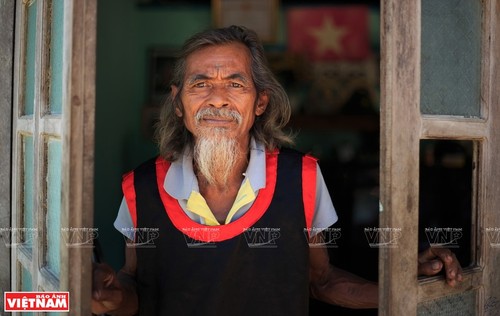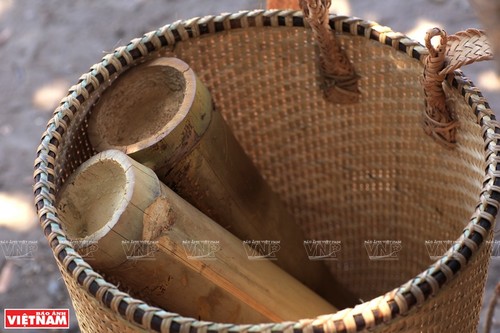 Emeritus artisan Chamalé Au of Ma Noi commune, Ninh Sơn district, Ninh Thuan province (photo: Nguyen Luan/ VNP) Emeritus artisan Chamalé Au of Ma Noi commune, Ninh Sơn district, Ninh Thuan province (photo: Nguyen Luan/ VNP) |
The Raglai have two distinctive musical instruments: the Chapi and the ma la, a percussion instrument made of bronze similar to the gongs of ethnic groups in the Central Highlands. Village elders explain that the Raglai use bamboo tubes to make the Chapi, mimicking the sound of the ma la. While the ma la set consists of five, seven, or nine pieces named the mother, father, and child ma la, the Chapi features eight strings, similarly referred to as the mother, father, and child strings.
The bamboo used to make the Chapi must be carefully selected. The maker goes up the high mountains to find the best bamboo plant with a diameter of about 7–8 cm and each node about 40 cm long. The ideal bamboo should be one year old, otherwise, it will not produce beautiful sounds. Each Chapi is handcrafted, carrying the personal imprint and soul of the maker.
Emeritus artisan Chamalé Au, the last Raglai man that can make and play the Chapi in Ma Noi commune, Ninh Sơn district, said: “When I go to the forest, I choose the bamboo plant that is not too thick or thin. Bamboo that grows in the valleys won’t produce sound; it has to be mountain bamboo. After cutting it, I dry it for at least five months. Fresh bamboo won’t make a sound. I can only make two instruments per day. It’s really difficult.”
 Bamboo tubes are dried before being used to make the Chapi. (photo: Nguyen Luan/ VNP) Bamboo tubes are dried before being used to make the Chapi. (photo: Nguyen Luan/ VNP) |
The Chapi looks simple with the body, strings, and pegs, but is actually very difficult to make. The hardest part is splitting the bamboo strands to make the strings. This step shows the artisan’s skill and craftsmanship, which requires meticulous attention and a lot of time. Each string must be thin and fine to create the signature sound.
Artisan Ka Tor Doi, in Phuoc Chien commune, Thuan Bac district, said: “I have to hollow out both ends of the bamboo tube which is about two hand spans in length. Then I split the bamboo outer layer into four pairs of strings around the tube and pin each end with a small bamboo piece to separate the strings from the body. Each pair of strings is connected by a small bamboo piece. I also drill holes in the tube to let the sound escape.”
The sound of the Chapi is not loud, just enough for those nearby to hear. It imitates the sounds of flowing water, rustling leaves, and the ma la gongs, which echo gently up and down the forest. In the past, Raglai people used to carry the Chapi with them to the fields. Its sound could help ease the tiredness of long workdays. At night, deep in the forest, they would gather and play the Chapi to break the silence of the vast wilderness.
For the Raglai people, the Chapi is not just a musical instrument for expressing their feelings, it’s also a symbol of their cultural identity. The Chapi's sound can evoke the essence of the mountains and forests.
 Emeritus artisan Chamalé Au check the sounds of the Chapi. (photo: Nguyen Luan) Emeritus artisan Chamalé Au check the sounds of the Chapi. (photo: Nguyen Luan) |
Mau Hong Thai, a Raglai man of Phuoc Hoa commune, Thuan Nam district, said that the Chapi is also played during ceremonies and traditional storytelling sessions.
“Even the poorest household has a Chapi. We play the it during festive days and bring it to the fields to scare off wild animals. During wartime, we even played the Chapi to entertain the soldiers and encourage young people to join the army.”
To preserve and promote cultural values of the Raglai people, Ninh Thuan province has opened classes teaching ethnic musical instruments and inspires the love of folk culture among local people.
Emeritus artisan Mai Tham of Phuoc Thang commune, Bac Ai district said: “If the Raglai don’t study or pass down this knowledge to future generations, then instruments like the ma la, Chapi, and gourd panpine will no longer exist. We should have training classes to preserve the beautiful culture of the Raglai.”
Many younger Raglai and tourists are interested in learning about the Raglai culture, said Kator Thi Tang of Phuoc Binh commune: “I was guided by artisan Mai Tham to play the ma la, gourd panpine, and Chapi. At first, it was hard, but after a few days of practice, I find it easier. We will continue to practice to preserve the Raglai ethnic identity.”
The joint efforts of the community and artisans in preserving and promoting the Chapi's values will help nurture the soul of generations of Raglai people, and the sound of the Chapi may forever echo through the forests and mountains.